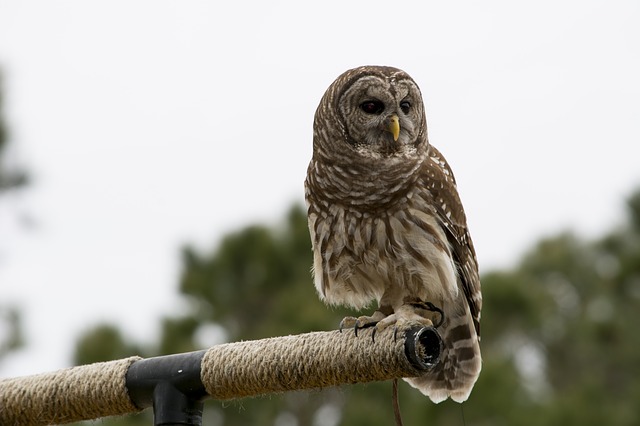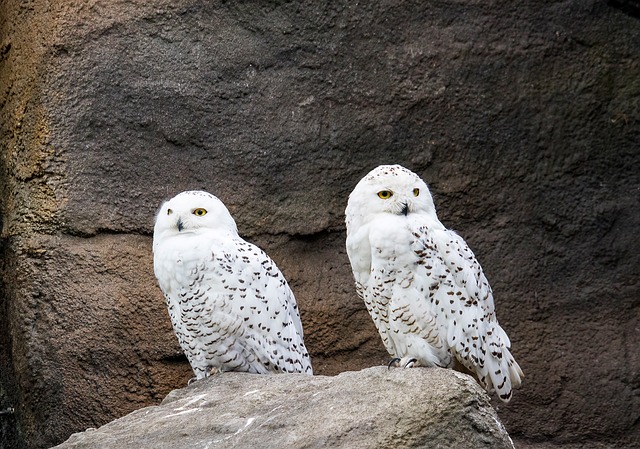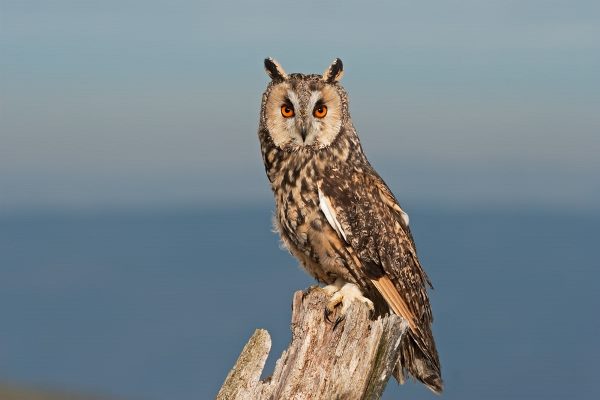Indiana is part of the midwest, just below the Great Lakes region in North America. The Hoosier state is known for many types of wildlife, including several different species of birds. Owls are among those winged avian wonders, and their large eyes and nocturnal nature make them truly interesting and beautiful to watch.
Below is a detailed list of information regarding the owls that live in the forests or grasslands of Indiana.
There are about 8 different species of owls that live in Indiana. Owls appreciate the Hoosier state’s continental climate as well as all of the national parks and wooded areas for them to live and hunt.
Here is the list of the 8 different species of owls in Indiana:
- Barn Owl
- Barred Owl
- Snowy Owl
- Great Horned Owl
- Eastern Screech Owl
- Northern Saw-Whet Owl
- Short-Eared Owl
- Long-Eared Owl
8 Types Of Owls In Indiana
1. Barn Owl

- Scientific name: Tyto alba
- Size: Medium
- Weight: 15 – 22 ounces (1.3 lbs)
- Wingspan: 42 – 47 inches
The Barn Owl is one that can be found in over 48 states in the US, and inhabits Indiana all year round. Southern Indiana is where these birds can be most often seen.
They are excellent night hunters and, like many owls, will swallow their prey whole and regurgitate pellets with their bones and fur intact. Barn owls enjoy hunting and eating mice, shrews and voles.
The Barn Owl gets its name because they prefer to make their homes in man-made structures, such as barns and abandoned homes. This owl can be easily recognizable with its distinct, heart-shaped face and beautiful plumage.
You will usually only see these owls at nighttime, as they are primarily nocturnal. This species of owl is known for their monogamous lifestyles with each other, occasionally you will find one that has multiple partners, but for the most part they form life-long relationships.
2. Barred Owl

- Scientific name: Strix varia
- Size: Large with stocky build
- Weight: 16 – 40 ounces (1 – 2.5 lbs)
- Wingspan: 37 – 49 inches
The Barred Owl is another species that can be found throughout the entire state of Indiana. A common tree dweller, this owl enjoys making nests inside hollow tree cavities and can be found in old-growth and more mature forests.
The Barred Owl has a round head and no ear tufts, with brown and grey feathers that make up a “barred” pattern on their wings, giving them their name. This species of bird does not migrate and can be found not only in Indiana, but as far north as Canada and as far south as Florida.
Many people recognize their sounds like “Who cooks for you?”. They are carnivores like most owls and can be found eating small mammals such as mice, squirrels and rabbits. Like the Barn Owl, the Barred Owl is also known for mating in monogamous pairs.
3. Snowy Owl

- Scientific name: Bubo scandiacus
- Size: Large
- Weight: 70 ounces (4.9 lbs)
- Wingspan: 59 inches
The Snowy Owl is an easily recognizable one, with its beautiful speckled white feathers and large yellow eyes. They are slightly larger than the Great Horned Owl which makes them the biggest owls in the state of Indiana. You can typically find these beautiful birds during the winter months, and usually only in the far northern areas near Michigan.
Snowy Owls will migrate to the far northern reaches of Canada and Greenland during the rest of the year for mating and usually live in areas with more grasslands than trees. They can be aggressive and have been reported diving at humans and other predators to scare them away.
Unlike most owls, these are not known for being nocturnal. They can be seen hunting and flying at any time of day. However, it would be a rare sight to behold because these birds are antisocial and prefer to live in areas away from humans. Snowy Owls enjoy eating fish, rabbits, other small mammals or birds and rodents.
4. Great Horned Owl

- Scientific name: Bubo virginianus
- Size: Large and strong
- Weight: 49 ounces (3 lbs)
- Wingspan: 51 – 57 inches
The Great Horned Owl can be found all over the state of Indiana, and they don’t migrate during the different seasons. They have an exceptionally varied habitat range and can be found in almost any climate. Their distinct looks are easy to recognize as they are frequently the quintessential owl of TV shows, movies and story books.
This species of owl has a reddish brown face with mottled grey and brown feathers. Their pointed ear tufts resemble small horns, earning them the name of the Great Horned Owl.
These large and fierce owls are excellent hunters of large prey, and are especially talented at catching and killing prey much larger than themselves. They are often the number one predator for many bird species, including the Red Tailed Hawk and the Barred Owl.
The Great Horned Owl will dine on large raptor species of birds, skunks, squirrels and rabbits.
5. Eastern Screech Owl

- Scientific name: Megascops asio
- Size: Small
- Weight: 5.6 ounces
- Wingspan: 19 inches
The Eastern Screech Owl is another that can be found all over the state of Indiana, all year round. They tend to stay in one place and not do too much traveling or migrating for that matter. They tend to stay in areas with trees and will nest in hollow cavities. They will take to using nesting boxes if one is provided in a safe enough location.
These owls tend to be mostly grey, with varying shades of darker and lighter colors to help them camouflage well with the bark of the trees. They have a short neck and a small, stocky build. Because they are smaller than several other species of owls, they can be victims to attack and hunting from other larger birds.
The Screech Owl is typically another monogamous bird. They will usually mate for life, except in some circumstances where selection is limited. A male may mate with two females.
Screech owls hunt much smaller prey than many owls, such as songbirds, mice, beetles, crickets and other little mammals or insects.
6. Northern Saw-Whet Owl

- Scientific name: Aegolius acadicus
- Size: Very small
- Weight: 3.5 ounces
- Wingspan: 15 – 23 inches
The Northern Saw-Whet Owl is the smallest owl you will find in Indiana. Not only that but they are the smallest bird of prey in the country of North America. They are no bigger than a Robin and can be found all over the state of Indiana, especially the northern parts. Because they are difficult to find and have rather elusive habits, the number of sightings is rather small in some areas.
The Northern Saw-Whet Owl has to be careful though. Because they are so small, they are easy meal-tickets for other larger predatory owls and birds, such as hawks and eagles. This little owl prefers to stay in areas of mature forest, typically near a water source.
North Saw-Whets like to feast on small mice, songbirds, shrews and voles. Their large yellow eyes and sweet faces are easy to love and their small frames are covered in brown feathers in varying shades with a white underbelly.
These little owls tend to mate with one partner at a time but are not known for making a life-long partner. They will usually find a new mate in each subsequent breeding season.
7. Short-Eared Owl

- Scientific name: Asio flammeus
- Size: Medium
- Weight: 7 – 16 ounces
- Wingspan: 33 – 43 inches
The Short-Eared Owl gets its name for, you guessed it, having short almost invisible ear tufts. These birds can be found all over the state of Indiana, but sightings of them in anywhere other than the northern parts of the state will be during their non-breeding seasons. This owl is a medium build with a round head and buff-spotted, brown feathers throughout.
While nighttime activities can certainly be seen with the Short-Eared Owl, they are not necessarily nocturnal. They can be spotted being out and flying at any time of day, especially when their breeding season starts.
The Short-Eared Owl is known for traveling great distances, they have been seen landing on boats hundreds of miles from land. These owls have traveled great lengths and have even been spotted in places like South America. These birds prefer to nest on the ground and can be seen more frequently in grassland areas.
Small animals such as voles, shrews and mice as their preferred prey.
8. Long-Eared Owl

- Scientific name: Asio otus
- Size: Average and stocky build
- Weight: 8.8 ounces
- Wingspan: 35 – 39 inches
As you can probably imagine, the Long-Eared Owl got its name from their distinctly tall ear tufts compared to most owls. They are a stout species of owl that has dark feathers with a white-framed orange face. They can be seen in Indiana, but not year round, they tend to only linger during the non-breeding seasons.
These owls are different from most because they actually form colonies that can sometimes reach up to 100 individual Long-Eared owls, outside of the breeding season, that is. They enjoy hunting in grassland areas but can be seen living alone or in a colony in forested habitats.
The Long-Eared Owl is typically nocturnal and sneaky and feasts on a normal diet of mice, small mammals, rabbits and occasionally other birds.
When the breeding season hits, the colony can lower in numbers but still nest near each other. These owls tend to be monogamous to their partner but there is scientific speculation that some males will change partners during the subsequent breeding seasons.
Conclusion
While there are many different species of owls, these 8 can be found in the great mid-western state of Indiana. Some may be more difficult to spot than others, but if you know how to spot them, visiting the many national forests could leave you with some great views of these beautiful birds.
Other Species of Birds in Indiana:
Woodpeckers in Indiana
Hummingbirds in Indiana
